While the total neutral detergent fiber content (NDF on a DM basis) of a forage crop is a major factor in defining the overall maturity at cutting, it’s by no means the last word in understanding the digestibility of this fiber fraction when eaten by the dairy cow or replacement heifer. The NDF fraction comprises the cell wall components, lignin, hemi-cellulose and cellulose.(See Figure 1.)
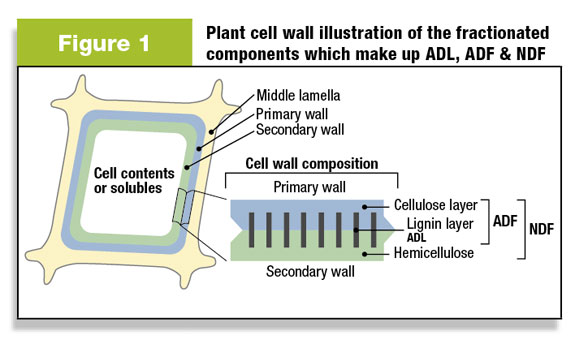
Despite the fact that NDF is the most common method of fiber assessment in forage and feed analysis, NDF is a heterogeneous mix of cell wall components, with an unknown digestibility.
Therefore, the NDF digestibility must be measured by a technique that reflects conditions in the rumen.
The NDF digestibility in a forage crop can be expected to be variable for all sort of well-known reasons related to crop and silage management, such as crop species and variety, soil fertility, growing conditions, temperature or water stress, stage of growth at cutting, primary or late-season growth, leaf loss, forage additive used, storage time in the bunk and heating/Maillard browning reaction, to name a few.
NDF digestibility is of significance because NDF can comprise from 40 to 60 percent of the forage crop dry matter content, so it is a major variable on how well that forage crop will perform in a dairy cow ration.
In vitro NDF digestibility
Recently, commercial feed laboratories have begun to use in vitro NDF digestibility (IV-NDFD) techniques using rumen fluid from donor cows, giving us a huge leap forward in measuring and benchmarking the relative NDF digestibility (expressed as percentage NDF) of all forage crops for dairy cows.
While there are variations between laboratories on technique and whether a 24-hour, 30-hour or 48-hour value was reported, most consultants gravitated towards 24-hour or 30-hour IV-NDFD values as more representative of what was likely to happen in the rumen of lactating dairy cows. Part of the learning curve was that individuals should not submit samples across the laboratories.
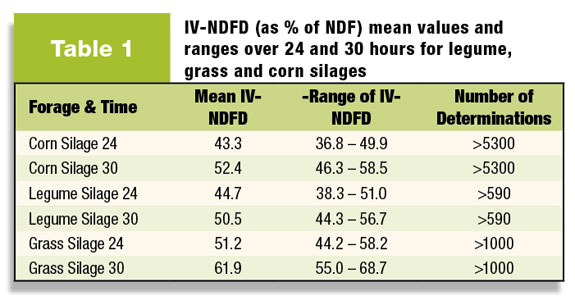
It was better to select one laboratory to work with and benchmark all forage samples against the population for that type of forage. Typical IV-NDFD values with ranges for three main forage types are summarized in Table 1.
From Table 1, we can see that within each forage type there was a wide range of IV-NDFD, which confirms the need to determine this value to better describe that forage and its potential performance in a dairy ration.
Forage crops with higher IV-NDFD values have a higher dry matter intake potential for milking cows in early lactation because these cows have appetite limits more likely influenced by physical constraints of the ration (i.e., fill or indigestible NDF).
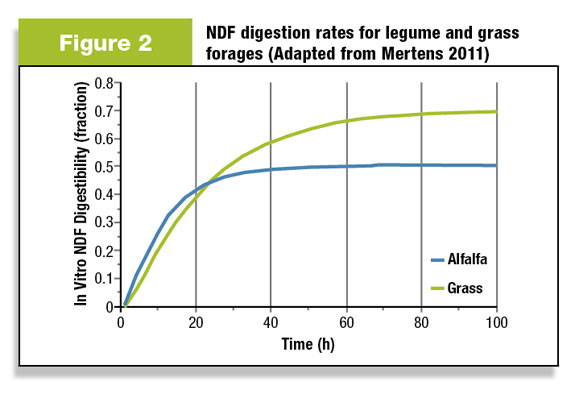
Noteworthy is the fact that at either 24-hour or 30-hour incubation time the grass silages, on average, have higher IV-NDFD values than either the legume silage or corn silage.
When harvested at similar stages of maturity there is less potentially digestible NDF, (pd-NDF) and more indigestible NDF, (i-NDF) in legumes than grasses. This is depicted in Figure 2.
While NDF content (as percentage DM) and IV-NDFD (as percentage NDF) give a better assessment of how forage will perform in a dairy cow ration, the rate of NDFD digestion (Kd as percentage per hour), is also important.
Relatively speaking, the Kd rate values are higher for pure legume forages than for pure grasses at similar stages of plant maturity (see Figure 2).
Although the legume forage has less digestible NDF than the grass forage, the pure legume forage is more fragile with a faster rate of digestion and potential escape from the rumen.
The use of IV-NDFD and Kd also helps in the differentiation of corn silages, especially between conventional and the lower lignin content BMR varieties.
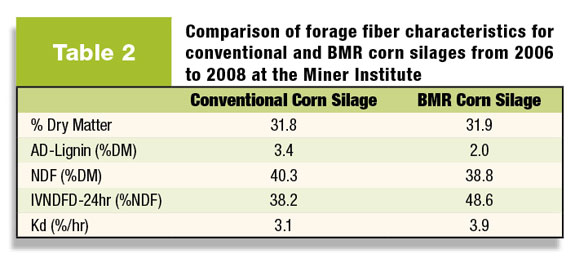
Some typical results for this corn silage comparison are outlined from work at the Miner Institute, Chazy, New York, from 2006 to 2008 and summarized in Table 2.
The lower lignin content BMR corn has a similar NDF content, but is 27 percent higher in IV-NDFD-24-hour and has a 25 percent higher Kd or rate of NDF digestion.
The practical significance of this is demonstrated when the corn silages are included in high-performing milk cow TMRs.
Due to the higher IV-NDFD and Kd values, cows fed TMRs prepared with BMR corn silage had higher dry matter intakes (up to +9 percent) and higher milk yields, (+4.4 pounds of SCM per cow daily) in comparative trials with conventional corn silage when both silages have been compared at equal inclusion rates.
One could expect similar results ranking legume or grass haylages for intake and milk production within their respective groups.
The Kd rate value can be provided by commercial analytical laboratories calculated from recently published equations.
As with many recent analytical developments, the IV-NDFD and associated parameters have lent themselves to more cost-effective and routine NIR analysis.
Consultants and their clients can now use this approach to benchmark forages for different pen allocations or troubleshoot in more detail a production problem related to particular forage or forages.
Looking within NDF – New developments
In the not-too-distant future, dairy farm teams and their consultants will be describing and benchmarking forage options with terms like indigestible NDF (i-NDF, as a percentage NDF) and potentially digestible NDF (pd-NDF as a percentage NDF).
I-NDF is the forage crop residue left that is not digestible in the rumen after prolonged incubation (e.g., 240 hours). It is related to lignin but not in a very uniform way across plant species or varieties.
This variability appears to be related to the types of chemical bonding between the lignin and primarily hemi-cellulose in the different plant species and at different stages of maturity.
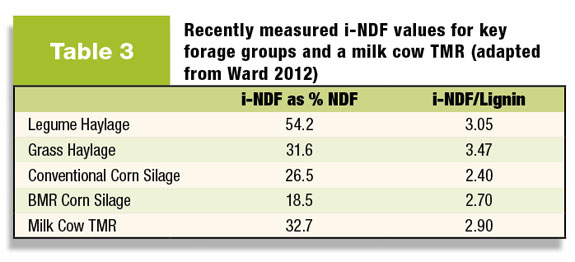
Some typical i-NDF values for forage crops and a milk cow TMR from recent work done by Cumberland Valley Analytical Services are summarized in Table 3.
From a dairy herd performance point of view, i-NDF offers:
- Better prediction of Kd (rate) and the pd-NDF fraction which comprises of at least two pools, one fast and one slowly degradable.
This will give a much clearer understanding of the differences between forages and how to adapt the ration to maintain or improve milk production.
- A very good relationship between i-NDF and organic matter digestibility, allowing a more precise understanding of energy supply to the rumen and microbial protein to the cow. Within computer models this could allow better control over grain and bypass protein inputs.
- A measure of the ration “ballast” or “indigestible load” in the anaerobic rumen environment. This would make it a good predictor of “fill” or appetite limit. Coupled with particle size, this could allow better prediction on dry matter intakes across all stages of lactation.
Forage evaluation and benchmarking – looking forward
NDF is the largest component of dry matter in forage. It is a non-uniform combination of cell wall fiber components, and it is important that we strive to understand it better.
Regular and more detailed analysis is now affordable with NIR and will allow rapid evaluation of forage changes to help increase forage inclusion and minimize loss of milk. Good points to consider with your consultant are:
- Make sure the forage sample is representative of what you are feeding and choose carefully a feed evaluation laboratory to direct your request to. It is important to use one laboratory for all analyses, to allow realistic comparisons with your own benchmarking dataset.
- Look beyond an NDF value only, and ask for NDFD-30-hour and Kd in your forage analysis. Review the results with your feed consultant; the higher NDFD and Kd forages will have a higher digestibility and intake potential. They are much more suitable for transition cows and high-producing cows in early lactation.
- For corn silages, be aware NDFD is only part of the digestible energy contribution of the crop. A good evaluation of kernel processing and starch digestibility is also
required. PD
References omitted due to space but are available upon request. Click here to email an editor.





